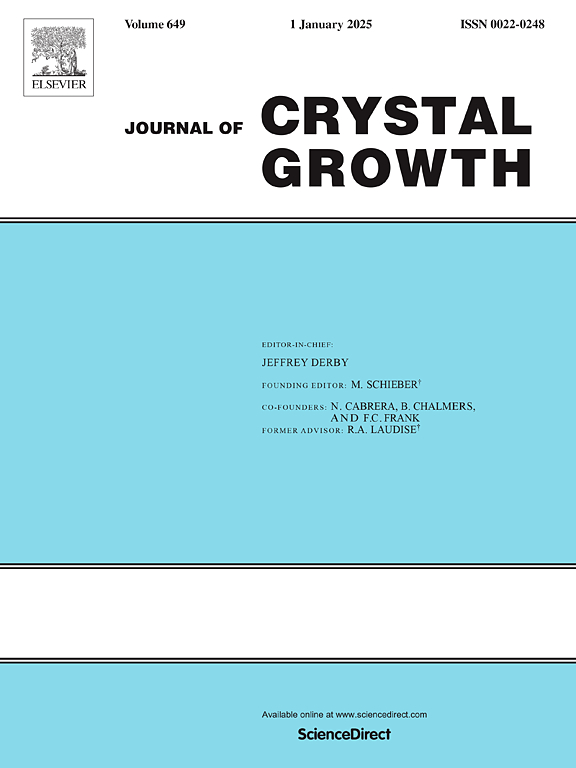采用边缘定膜生长法和数值分析共同设计的β-Ga2O3单晶的系统表征和缺陷分析
IF 2
4区 材料科学
Q3 CRYSTALLOGRAPHY
引用次数: 0
摘要
采用边缘定义薄膜生长技术和数值模拟技术,系统地研究了具有超宽带隙的高质量β-Ga2O3单晶的热场结构和缺陷形成的共同设计优化与分析。为了验证晶圆尺度的质量,提出了微观和宏观尺度的协同验证方案。半最大全宽较窄(139.82 arcsec),平均缺陷密度较低(5.5 × 104 cm−2),突出了大块晶体的高质量。由于存在与角度无关的单峰,通过旋转电子自旋共振证实了晶体中整体缺陷密度较低。通过第一性原理计算,验证了Zr为主要杂质,并研究了Zr作为有效n型掺杂剂的作用。并将缺陷形成的微观机制解释为原子排列紊乱和晶格畸变。本研究为进一步改进和优化β-Ga2O3单晶生长和缺陷表征提出了新的建议和策略。本文章由计算机程序翻译,如有差异,请以英文原文为准。
Systematic characterization and defect analysis of β-Ga2O3 single crystals co-designed by the edge-defined film-fed growth method and numerical analysis
Co-designed optimization and analysis of thermal field structure and defect formation for high quality β-Ga2O3 single crystal with ultra-wide bandgap has been systematically investigated via edge-defined film-fed growth technique and numerical simulation. To confirm the wafer-scale quality, a collaborative verification scheme is developed at both microscopic and macroscopic scales. The narrow full width at half-maximum (139.82 arcsec) and low average defect density (5.5 × 104 cm−2) highlight the high quality of the bulk crystal. The overall low defect density in the crystal is confirmed through rotated electron spin resonance owing to the appearance of angle-independent single peak. The dopant of Zr is verified as the main impurity and the role of Zr, an effective n-type dopant, is investigated by first principles calculation. Moreover, the microscopic mechanism of defect formation is interpreted as atomic arrangement disorder and lattice distortion. This study presents novel proposals and strategies for the advanced improvement and optimization of β-Ga2O3 single crystal growth and defect characterization.
求助全文
通过发布文献求助,成功后即可免费获取论文全文。
去求助
来源期刊

Journal of Crystal Growth
化学-晶体学
CiteScore
3.60
自引率
11.10%
发文量
373
审稿时长
65 days
期刊介绍:
The journal offers a common reference and publication source for workers engaged in research on the experimental and theoretical aspects of crystal growth and its applications, e.g. in devices. Experimental and theoretical contributions are published in the following fields: theory of nucleation and growth, molecular kinetics and transport phenomena, crystallization in viscous media such as polymers and glasses; crystal growth of metals, minerals, semiconductors, superconductors, magnetics, inorganic, organic and biological substances in bulk or as thin films; molecular beam epitaxy, chemical vapor deposition, growth of III-V and II-VI and other semiconductors; characterization of single crystals by physical and chemical methods; apparatus, instrumentation and techniques for crystal growth, and purification methods; multilayer heterostructures and their characterisation with an emphasis on crystal growth and epitaxial aspects of electronic materials. A special feature of the journal is the periodic inclusion of proceedings of symposia and conferences on relevant aspects of crystal growth.
 求助内容:
求助内容: 应助结果提醒方式:
应助结果提醒方式:


